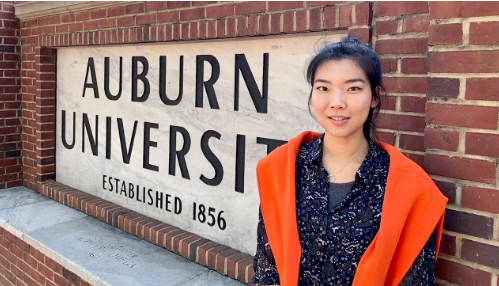Asteroid between Jupiter and Mars named after aerospace engineering graduate student
Published: Jun 23, 2023 2:00 PM
By Staff Report
Yaeji Kim, a fifth-year graduate student in aerospace engineering, was among six Auburn University researchers to have asteroids named in their honor for contributions to planetary science during the Asteroids, Comets, Meteors (ACM) Conference June 18-23 in Flagstaff, Arizona.
Kim, an active member of the Auburn University Space Technology Applications Research (STAR) lab under the direction of Masatoshi Hirabayashi, was awarded the prestigious Zonta International Amelia Earhart Fellowship and the LSSTC Data Science Fellowship Program at Northwestern University.
“Naming asteroids is a long tradition in the planetary science community,” Kim said. “When I heard that I got an asteroid named 'Yaejikim,' I was so happy that the community eventually recognized me as a part of the community. It means a lot to me. This says my research has some contributions to the community and further in the planetary science field.”
The asteroid, located between Mars and Jupiter, even has a web page, which showcases its orbit within the solar system. Kim said keeping track of the asteroid, and possibly researching it, would be a “cool experience.”
Others honored at the conference included postdoctoral researchers Youssef Moulane, John Noonan, Mohi Saki, Zexi “Lucy” Xing and Kumar Venkataramani, each from the College of Sciences and Mathematics’ Department of Physics.
Moulane was honored for increasing awareness of science in Africa. Moulane, who observed a great comet earlier this year, was instrumental in bringing a major astronomy meeting to South Africa.
Noonan received a $493,072 grant from the Association of Universities for Research in Astronomy to investigate the role of sulfur in comets and was honored for his work combining observations of comet 67P/Churyumov-Gerasimenko with the Hubble Space Telescope with gas measurements obtained by instruments on board the Rosetta space mission.
Saki used the James Webb Space Telescope to uncover core elements of Comet 238P and was able to confirm water production rates and determine that it did not emit levels of carbon dioxide.
Xing, a visiting scholar, observed the first active interstellar comet 2I/Borisov and measured its water production rates, showing that the object was eroding rapidly.
Venkataramani, a former postdoctoral researcher now at Caltech, conducted research on astronomical spectra. His research, using ground-based and orbital telescopes, has advanced our understanding of the chemical composition and reflectance properties of small solar system bodies. Media Contact: , jem0040@auburn.edu, 334.844.3447
Yaeji Kim is a member of the Auburn University Space Technology Applications Research lab.

